CITIZENS WITNESS LIBERATION BY FIRELIGHT
Sainte-Mère-Église, Liberated France • June 5, 1944
On this date in 1944 the stolid citizens of Sainte-Mère-Église, located near the center of the Cotentin Peninsula in Normandy, France, retired to their beds on the eve of the largest air- and seaborne invasion in history—Operation Overlord. As early as 1942, U.S. military planners had been eyeing this picturesque crossroads town of sturdy two- and three-story homes, shops, and churches solidly built of a whitish-grayish-yellowish limestone unique to the area. The town sat on the N13 Road and was located west of Utah and Omaha invasion beaches 6–8 miles away. If the Allies could gain control of Sainte-Mère-Église, they could deny German reinforcements the most likely route to the U.S.-assigned landing beaches. It would also cut the road and rail links to the vital deepwater port of Cherbourg, a bit more than 30 miles northwest of Utah Beach. (Utah was the most westerly of the five Allied landing beaches.)
Most of the over 13,000 parachutists whose drop zones were in the dark fields around Sainte-Mère-Église and Carentan landed safely in the predawn blackness of June 6. However, 20 or so men—primarily from F Company, 505th Parachute Infantry Regiment, 82nd “All American” Division and a few from the 101st Airborne Division (“Screaming Eagles”) as well—accidentally landed in and around the town’s church square, where many were killed by the fleeing German occupiers, their bodies left lying on the pavement or hanging from trees and poles. Reinforced at daybreak, the lightly armed sky soldiers held the crossroads and town until fresh additions of U.S. armor and infantry arrived from nearby Utah Beach in the afternoon of June 7. Today hanging from the town’s church steeple is a life-size effigy of Pvt. John Steele, whose canopy snagged the spire, leaving him dangling helplessly for two hours as one of two witnesses to the carnage and chaos taking place in the churchyard below, the cloud-obscured night sky pierced by the light of a two-story house fire that made the descending paratroopers easy targets for the German defenders. (Steele pretended to be dead.) The effigy is a permanent memorial to the brave Americans who liberated the first town in France.
Although the 82nd Airborne had taken its chief objective, it had landed close to German units and would suffer numerous counterattacks. Meanwhile, the sizeable bridgehead established by the Allies’ precisely timed air, naval, and amphibious “shock and shatter” attacks overwhelmed the static German coastal defenses. The three British and Canadian beaches (Gold, Juno, and Sword) were joined together on June 7, and a day later they linked up with Omaha Beach. By June 12 Utah Beach was incorporated within the 50‑mile front. However, the Norman bocage and its maze of thick, tall hedgerows and ditches behind the landing beaches bogged down follow-on operations, not helped by an increasingly determined German defense that slowed Allied progress.
Around the same time as the nylon chutes of Anglo-American paratroopers filled the gray-black skies behind the invasion beaches, thousands of French Resistance fighters began turning up the heat on the occupiers. It started with communications problems. Towns, cities, and German garrisons from Paris to Normandy and Brittany were being isolated from the outside world and from each other by cut telephone/teletype, highway, and rail lines. And radios started screeching maddeningly due to activated jammers that had been dropped earlier to Resistance groups. As dawn broke on June 6, 1944, reports trickled in of Normandy’s beaches being pummeled from the air and sea and filling up with enemy soldiers. Although on full alert, Normandy’s defenders at the shoreline and in command bunkers further inland; at regimental, divisional, and corps headquarters—even top brass in Paris at Western Army (Westheer) headquarters—reacted to the invasion as if hit by a ton of bricks. Months of agonizing invasion suspense regarding when and where were blessedly ended. The invasion was here, now.
![]()
Sainte-Mère-Église: First French Town Liberated on D-Day
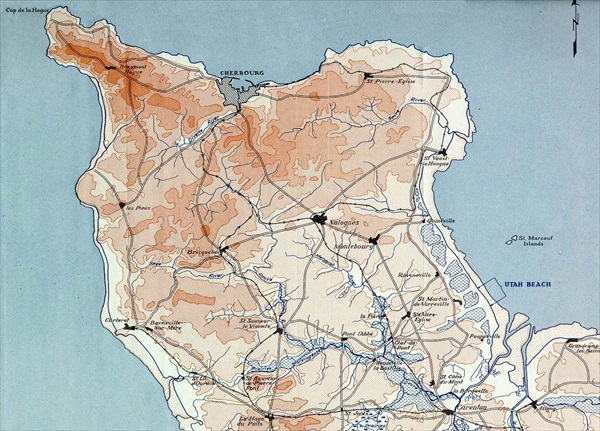 |
Above: Map of Cotentin Peninsula showing the location of Utah Beach, the crossroads town of Sainte-Mère-Église roughly 6 miles to the rear of the U.S. landing beach (admittedly hard to see but directly to the left), and the port of Cherbourg near the northern tip of the peninsula. Like Sainte-Mère-Église, Cherbourg was at the top of the list of U.S. objectives in the first days of Operation Overlord because the port city lay a little over 70 nautical miles from the logistic ports in England. On June 24, U.S. troops entered Cherbourg against fierce opposition; three days later the city was declared secured. With that, the Allies prepared themselves for a new and deadly phase of combat—the Normandy breakout and Allied advance all the way to the German border by mid-September 1944.
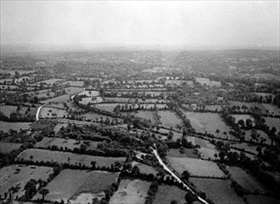 | 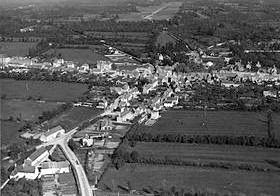 |
Left: Bocage country (hedgerow country) on Normandy’s north-jutting Cotentin Peninsula, France. Bocage terrain is a mixture of woodland and pasture, with fields and winding country lanes sunken between narrow low ridges and banks of ancient, thick hedgerows that break the wind and limit soil erosion but also limit visibility. German Field Marshal Erwin Rommel, whose Army Group B was responsible for the defense of the Cotentin Peninsula, had recently come to appreciate the suitability of the patchwork bocage country for airborne landings: it was relatively easy for paratroopers and glider troops to land in open areas and then quickly hide in the hedgerows. On the flip side, bocage country made progress against German defenders difficult and dangerous for the Allies. Aerial bombing, bulldozers, and tanks outfitted with steel “teeth” welded to their fronts (former German tank obstacles scavenged from the Normandy beachhead) were used to bust through the vexing hedgerows. The “inventor” of the hedgerow buster received the armed service’s Legion of Merit for his contribution to the success of the Normandy Campaign.
![]()
Right: Aerial view of Sainte-Mère-Église, Normandy, June 1944. For the Germans, Sainte-Mère-Église was the gateway to Utah Beach. At 10 a.m., June 6, German attacks on the town began with a fury, and by early afternoon enemy armored columns were slamming the 505th Parachute Infantry Regiment of the 82nd Airborne Division from three directions in an attempt to reach the vulnerable invasion beaches. The battle to retake or hold Sainte-Mère-Église turned into a “donnybrook”—an Irish term meaning an “uproarious brawl”—and ended the next day when American tanks and infantry from Utah Beach arrived to secure the French hamlet.
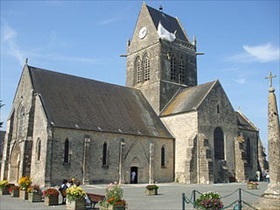 | 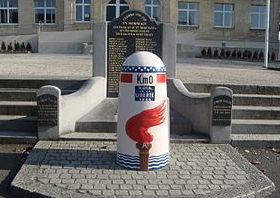 |
Left: This church in Sainte-Mère-Église, with its parachute memorial (the white drape on the roof of the bell tower), recalls the famous incident involving 31‑year-old John Steele of the 505th Parachute Infantry Regiment, 82nd Airborne, whose chute caught on one of the rear steeples (not the one shown here) of the church bell tower. (Steele was played by the American actor Red Buttons in the Academy Award-winning 1962 epic D‑Day film The Longest Day.) Wounded in the foot by gunfire and taken prisoner, Steele later escaped and rejoined his division. Another paratrooper, 17‑year-old Ken Russell, was snagged by the church roof, though his story is not as well known. Both witnessed their comrades, among them a sergeant who attempted to rescue them, being killed in the firefight that erupted early on June 6. Steele was awarded the Bronze Star for valor and several Purple Hearts for combat wounds. Upon completing operations in the Sainte-Mère-Église area, the 505th Parachute Infantry Regiment was awarded the Presidential Unit Citation.
![]()
Right: Erected by the French Government in 1946, this marker outside the town hall of Sainte-Mère-Église, Km 0, is recognized by Frenchmen as the commencement point for their country’s liberation from Nazi Germany (Borne 0, point de départ de la voie de la Liberté). On and around June 6 every year local people, veterans, and visitors crowd the town square in a festive spirit. Bands play and parades are impromptu with bagpipes playing and drummers drumming. Over the town hall flies the American Stars and Stripes to commemorate the day of liberation. Sadly in the Normandy Campaign alone, 15,000 French civilians died either from Allied bombings or in combat operations between Allied (including French Resistance fighters) and German ground forces, a little known statistic.
Associated Press News Agency Reports Normandy Landings and Liberation of Paris
![]()

 History buffs, there is good news! The Daily Chronicles of World War II is now available as an ebook for $4.99 on Amazon.com. Containing a year’s worth of dated entries from this website, the ebook brings the story of this tumultuous era to life in a compelling, authoritative, and succinct manner. Featuring inventive navigation aids, the ebook enables readers to instantly move forward or backward by month and date to different dated entries. Simple and elegant! Click
History buffs, there is good news! The Daily Chronicles of World War II is now available as an ebook for $4.99 on Amazon.com. Containing a year’s worth of dated entries from this website, the ebook brings the story of this tumultuous era to life in a compelling, authoritative, and succinct manner. Featuring inventive navigation aids, the ebook enables readers to instantly move forward or backward by month and date to different dated entries. Simple and elegant! Click 











